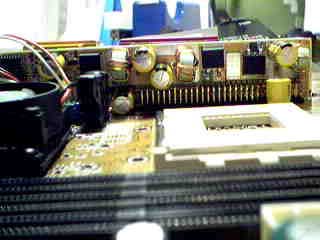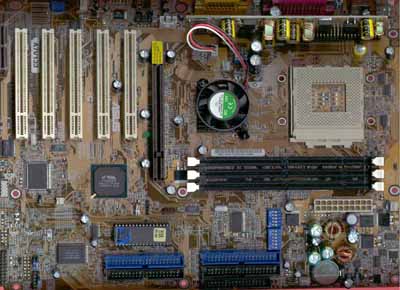VIA KT133A Motherboard Roundup - June 2001
by Mike Andrawes on June 13, 2001 2:52 PM EST- Posted in
- Motherboards
ASUS A7V133
|
ASUS A7V133 |
|
|
CPU
Interface
|
Socket-A
|
|
Chipset
|
VIA KT133A Promise PDC20265 IDE RAID (Optional) |
|
Form
Factor
|
ATX
|
|
Bus
Speeds
|
90 / 95 / 100 - 166 MHz (in 1MHz increments) |
|
Core
Voltages Supported
|
1.10 - 1.85 V (in 0.05V increments) |
|
I/O
Voltages Supported
|
3.35
/ 3.56 V
|
|
Memory
Slots
|
3
168-pin DIMM slots
|
|
Expansion
Slots
|
1
AGP Slot |
|
On-board
Audio
|
VIA
VT1611A AC'97 CODEC
|
|
BIOS
|
Award Medallion BIOS 6.00 |
Most KT133A boards are strongly based on their original KT133 counterparts,
usually with the same PCB, features, and to a large extent BIOS. ASUS is never
one to follow the status quo, however, and the A7V133 is one of the few boards
here that received significant improvements over its KT133 predecessor. The
board physically looks more or less the same as the A7V, including the unique
vertically mounted voltage regulator setup. The only obvious change is the addition
of a nicely designed HSF that sits atop the 8363A North Bridge.

ASUS has yet another unique design, with the vertically mounted PCB on the A7V133
Without a doubt the most impressive improvement on the A7V133 is the migration to 1MHz increments in FSB speeds. With the old A7V, we complained that the lack of 1MHz increments hurt overclocking potential for those looking to maximize the performance over the CPU. It's clear that ASUS listened to their customers and made the corresponding changes.
Multiplier settings are also nicely implemented in the BIOS this time around, so you should have no problem overclocking on the fly, without shutting down your system. Further, a wide spectrum of CPU core voltages is also available in the BIOS. The only non-jumpered option on the A7V133 is the I/O voltage, which is still controlled through a jumper.
Stability of the A7V133 has been outstanding in our stress tests. In fact, the A7V was among the most stable motherboards we have tested and did not crash once in 48 hours of stress testing. This is quite impressive since we generally encountered at least one crash for every 24 hours.
Of course, it seems that no board today would be complete without onboard IDE RAID, so the A7V133 comes with an optional Promise Ultra ATA 100 RAID controller. The old Promise controller used on the A7V acted as just a standard IDE controller, without RAID support, but that's been upgraded here. Note, however, that ASUS uses what they call a Lite BIOS for the RAID setup, which only supports RAID 0 configurations - RAID 1 and RAID 0+1 are completely missing. Fortunately, RAID 0 is the setting that the vast majority of people are likely to use. If you're still not satisfied with that, there is already information on the web that explains how to get full support for the missing two RAID configurations. However, keep in mind that you are modifying the BIOS and there is a chance that you could ruin the BIOS.

The newer Promise controller allows RAID 0 setups only
Since ASUS is one of the largest OEM suppliers of motherboards, they have to please their customers in those markets as well, so sometimes their designs are not fully geared towards hardware enthusiasts. The board features five PCI slots and one AMR slot - not very impressive in the face of boards with six PCI slots, especially since the AMR slot is not useful for most of us.
Unlike the A7V, ASUS took away the additional three USB ports provided by an onboard USB hub chip, leaving the standard four USB ports supported by the 686B South Bridge. This was probably done as a cost cutting measure, and it may still be possible to order the board with the chip installed as an option.. Last of all, like most other recent ASUS boards, the A7V133 features an AGP Pro slot.
It is safe to say that the A7V133 is one of the best KT133A boards in the market. The addition of 1MHz increments when adjusting FSB speeds makes the board a complete package for overclockers, while the excellent stability under all circumstances will satisfy everyone. We were able to reliably hit 153MHz FSB in the AnandTech labs.











0 Comments
View All Comments